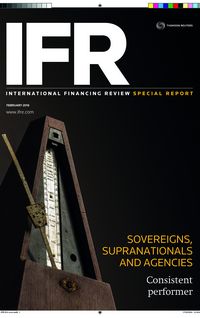Finland’s Municipality Finance last year became the first SSA issuer to raise its leverage ratio by issuing AT1 capital, but it may not be the preferred option for other agencies.
Students that go the extra mile on particular assignments and complete them well in advance of the deadline tend to illicit a range of reactions from their peers. A few may look to replicate their success, but others might cut corners to complete the work more quickly or shrug their shoulders and leave it for later in the hope of an extension.
A similar range of reactions has been evident when it comes to compliance with Basel III; in particular the leverage ratio, which is due to become a binding requirement in less than two years’ time. For many commercial banks, exceeding the minimum 3% ratio has been a priority for some time, but state-guaranteed development banks have taken disparate approaches to the requirement. At least one – Municipality Finance in Finland – has opted to issue high-quality capital to increase its leverage ratio, but not everyone is convinced other agencies will follow its lead.
“There is no doubt that some of the state-owned agencies currently fall below a 3% leverage ratio under Basel III, but I don’t think issuing in the public market will necessarily be the preferred way of raising additional capital. There are more cost-effective options available, such as retaining earnings or seeking private placement solutions from members or third-party investors,” said Philip Brown, head of sovereign, supranational and agency origination at Citigroup.
For all the apparent simplicity of the leverage ratio in keeping a check on excessive gearing of bank balance sheets, it has become one of the most complex and controversial components of the Basel III package. As calibrated during the current testing and observation period, the minimum requirement is that a bank’s Tier I capital divided by its total exposure must amount to 3% or more. Subject to final review, that will become a binding Pillar I measure in the regulatory capital framework from January 1 2018.
The key question has always been how this non-risk-sensitive backstop measure would interact with the core capital ratios enshrined in Basel III. That naturally depends on the risk profile of every bank, and for many institutions the leverage ratio may be of little concern, as the capital ratios will generally be the binding constraint. But banks that take comparatively little risk may find themselves constrained by the leverage ratio rather than the capital ratios.
State-owned development banks that serve as funding vehicles for public investment projects are a case in point. In comparison with major commercial banks, the risks taken by such agencies are low, but they are still legally classified as banks and must therefore comply with Basel III. While their capital ratios may well be modest, the leverage ratio covers their total exposure with no accounting for risk, so it could be much more punitive.
“Most development banks don’t hold very risk-intensive assets, so their capital requirements are likely to be comparatively low and can reasonably be met with retained earnings. But as soon as they have to comply with the leverage ratio, which is not risk-based, that will become the binding constraint rather than capital ratios, and they will either need to raise equity capital or issue additional Tier I (AT1) capital,” said Roberto Henriques, head of financials credit research at JP Morgan.
“The rationale for issuing AT1 capital doesn’t necessarily differ between commercial and state-guaranteed banks,” Henriques added. “Irrespective of the size or function of a bank, AT1 is cheaper than core equity, so it’s a good way to meet minimum requirements and reduce leverage with an efficient capital structure.”
There are clear signs that agencies are now beginning to heed such advice in their preparations for Basel III. A landmark €350m capital deal issued by Municipality Finance in September 2015 had the clearly stated aim of raising the company’s leverage ratio, while Dutch development bank FMO (Nederlandse Financierings-Maatschappij voor Ontwikkelingslanden) issued €175m of subordinated notes on November 30 2015 to get its capital ratios in order.
Filling the gap
“FMO had a good capital base, but like a lot of the government-owned agencies, it needed to address its total capital ratio and opted to raise capital to fill that gap. In the early days, there was a reluctance to admit the need for capital and a lot of firms considered retaining earnings or changing their risk profile, but there has been a realisation that those options may reduce capacity to service clients,” said Ulrik Ross, global head of public sector debt capital markets and sustainability at HSBC.
The Munifin transaction – the first ever public AT1 bond from an SSA issuer – was significant not only for being the first of its kind but also because it dealt directly with the imbalance that existed between the agency’s capital and leverage ratios. Munifin’s Common Equity Tier I ratio at the end of June 2015 was 30.1% – well in excess of the 4.5% required under Basel III – but its leverage ratio was 1.9%, some way short of the required 3%.
“As a financial institution, we have to comply with all of the banking regulations and we didn’t have any problems with the capital adequacy, funding or liquidity ratios, but the leverage ratio was the real challenge. Initially, we opted to raise capital by increasing our profitability, but in 2014 we gained board approval to prepare for an AT1 transaction,” said Esa Kallio, deputy chief executive and head of capital markets at Munifin.
Following the September 2015 issue, Munifin is now compliant with the Basel III ratios as currently calibrated, with its leverage ratio reported at 3.15% as at December 31 2015. As the first transaction of its kind in the SSA sector, the deal required extensive preparation to get the necessary documentation and approvals in place and to make sure investors understood what was being offered.
“We didn’t have a problem finding interest in the deal, but the challenge was that we were the first SSA issuer and also the first Finnish issuer of AT1 capital, so there was really no price reference for the transaction. We sent three separate teams out on the road, covering Helsinki, the other Nordic countries, Switzerland, the Netherlands, France and the UK,” said Kallio.
The rigorous approach paid off and Munifin managed to attract a total of 110 investors to buy the debt. While more than 40% of the transaction was sold to existing shareholders, the agency also attracted a number of other investors that had not previously bought its senior debt.
“Munifin had to strike a balance between the rigorous cost-efficiency that is demanded of a public sector agency and the need to offer appropriate value to attract buyers. Investors were attracted to this new asset, in that they had an extra level of complexity compared to the usual senior debt, yet it was a rare opportunity in this product for access to a very highly rated credit with strong ties to local government,” said Lee Cumbes, head of SSAR origination for Europe, the Middle East and Africa at Barclays, one of the lead managers of the transaction.
No deluge
But despite Munifin’s success, and the clear challenges associated with the leverage ratio, even those closest to the transaction, believe it is unlikely to kick off a string of public issuance from other agencies. Some dealers see insufficient investor appetite, while others remain convinced agencies will stick to more conventional and cost-effective mechanisms for raising their leverage ratios.
“Even though the state-owned banks are regulated by the banking supervisory authorities and the European Central Bank, investors don’t perceive the risks associated with agency capital in the same way as that of private sector commercial banks. The agencies that have raised capital through private placement have achieved substantially tighter pricing than public market deals,” said Citigroup’s Brown.
Barclays’ Cumbes agrees. “Munifin did an excellent job of preparing the deal, marketing it to investors and establishing the product, but I’m not sure this will yet kick off a whole new class of issuance, with different entities looking for different solutions,” he said.
Given the fundamental differences between development banks and commercial banks, particularly when it comes to risk, some agencies may still be hoping for lighter touch treatment from regulators – and there is a small window next year during which such special treatment could be granted.
At an international level, the Basel Committee had always planned for final adjustments to the definition and calibration of the leverage ratio to be carried out in the first half of 2017, prior to its full implementation in 2018. The European Union’s Capital Requirements Regulation is more explicit, stating that when reviewing the impact of the leverage ratio, “particular attention should be paid to business models which are considered to entail low risk, such as mortgage lending and specialised lending with regional governments, local authorities or public sector entities”.
It will be up to the European Banking Authority to determine whether the leverage ratio should indeed be calibrated differently for certain institutions, and that decision will be based on data collected during the ongoing transition period. While it would be prudent for development banks in Europe to prepare for the standard leverage ratio, there is clearly a chance of some relief.
“It is still possible that SSA issuers might be allowed to meet a lower leverage ratio requirement to account for the low-risk nature of their business. But there has been no concrete confirmation of this, and there is a distinct possibility they will either be required to meet the global 3% standard or will wish to do so in order to benchmark themselves against their commercial peers,” said Ross at HSBC.
To see the digital version of this special report, please click here
To purchase printed copies or a PDF of this report, please email gloria.balbastro@thomsonreuters.com



